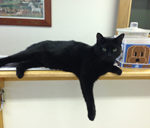 The thought of having to bring one of my feline crew in for a veterinary visit doesn’t exactly make me dance with delight. Even though I am a trained professional, with one or two of my cats, it is often a rodeo to try and round them up to get them in their carrier. Then I am serenaded in the car either by screaming and howling, or the sounds of vomiting. But I know that it is necessary; indoor cats need yearly exams, felines are masters of disguise. Because most cats are food and water grazers, we often don’t notice things until after they have been going on for a while. It is as if a light goes off in our brain-I don’t think Fluffy is eating all her food, or “boy the litter box seems pretty full lately.” cats may seem perfectly normal on the outside, when in reality, their health is in turmoil.
The thought of having to bring one of my feline crew in for a veterinary visit doesn’t exactly make me dance with delight. Even though I am a trained professional, with one or two of my cats, it is often a rodeo to try and round them up to get them in their carrier. Then I am serenaded in the car either by screaming and howling, or the sounds of vomiting. But I know that it is necessary; indoor cats need yearly exams, felines are masters of disguise. Because most cats are food and water grazers, we often don’t notice things until after they have been going on for a while. It is as if a light goes off in our brain-I don’t think Fluffy is eating all her food, or “boy the litter box seems pretty full lately.” cats may seem perfectly normal on the outside, when in reality, their health is in turmoil.
A recent research study published in the Journal of Feline Medicine and Surgery described findings in 100 APPARENTLY healthy cats. The group consisted of cats 6 years old and older. All cats underwent a complete physical exam, bloodwork, urinalysis, and other screenings. The only owner complaint noted for the group was a bit of arthritis in 2 of the oldest cats. Some of the abnormalities reported are as follows:
- Gingivitis-72 cats
- Urine crystals (can be signs of infection or chronic irritation)-41 cats
- Elevated kidney values-29 cats (when renal values are elevated, the kidneys are already 75% damaged)
- Heart murmurs-11 cats
- Elevated blood pressure-8 cats
Fewer than half the cats had an ideal body condition-meaning they were not too heavy, nor too thin.
All of the data proves that although they may appear healthy, many middle aged and older cats have abnormalities that may benefit from early veterinary intervention. Call for an appointment, grab your gloves or towels, and let the festivities begin. YAHOO!!!
